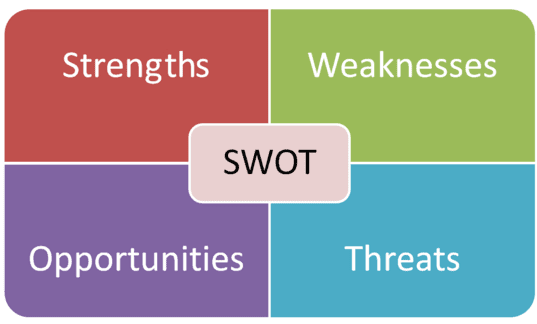Gujarat, Textile wet processing industries are settled with huge numbers itself. Approximately 600 – 700 process houses are running their business including large scale to small scale, in Gujarat. Cotton in Ahmedabad, Synthetic like polyester in Surat, majorly covering the market. Small areas are also dealing in Kutchchh, Jetpur, Jodhpur, Bharuch, Ankleshwar etc. But the areas are beneficial, economically strong for textiles, working resources are manageable are the basic parameters for the settling the industry. For that, SWOT analysis is must. SWOT means Strength, Weakness, Opportunities and Threats. Here, the literature is dealing with the analysis for Textile Wet Processing industries in Gujarat.
Introduction
Any Organization undertaking the SWOT analysis (strengths, weaknesses, opportunities and threats analysis) for analyzing its strength and weakness present internally and opportunities and threats for them settled externally.
Agriculture is the first largest industry, which provides employment and textiles, second largest employment provider in India. Around 38 million people are performing duties in textile and apparel industries. 14 % industrial production has been covered by textile industries. India’s 8 % GDP is with these industries. 21 % export market of India, handed by textile and apparel organizations. So the SWOT analysis for further development is necessary.
SWOT Analysis
Strength:
- Self-reliant and Independent textile process houses are in major number in Gujarat.
- In concern with cotton and polyester, raw materials are available in sufficient level. In 2019-20, till Feb – 20, Gujarat has produced 9,272,630 tons cotton, which is 52.2 % in crop market of the state. Also fast growing in synthetic fabric producers.
- Gujarat majorly covers good entrepreneurs. Gujarat textile industries handed by these entrepreneurs for setting up to growth of industries.
- Textile processing industries are rich in the case of cheap and skill labours, which are highly in demand for running the industries successfully.
- Due to fashion, comfort and innovations, demand of variously processed textile materials are demanded in huge quantity.
- Particular areas (SEZ park) built by Government of Gujarat for textile industries.
- Economy of textile market is growing day by day, specifically in Gujarat.
- Government has started skill development courses for textile wet processing labours and apparel manufactures requirement.
- Community Development programs also running for improving the sewing and stitching skill by Government in both, rural and urban areas.
- Various sectors involved in textile processing market and apparel industries are bifurcated as follow:
- Pretreatment units
- Dyeing and Printing units
- Finishing units
- Washing units (Laundry units)
- Stitching units
- Garment units
- Special art producers on textile and apparel
Weakness:
- Cotton produced in Gujarat is highly contaminated, compare to other states and countries. So the yield of large produced raw material is low. The quality of such material is also poor.
- For improving the quality and production, technology is lacking in Gujarat. Still farmers following traditional methods without up gradation in techniques.
- Labours –laws are unfavorable, and technology is old. So the skills of labours are less compared to other countries. So the production declined.
- Communication between Government, Industries and Labours has not any identical strategy and correspondence to such situation.
- Industries have not any value addition department for improving their product to sustain in foreign market.
- Power, Indirect Taxes and Rate of Interests are much higher. Industries are in heavy debt.
- Certification for labours skill advancement is not demanded by textile wet processors and apparel manufacturers.
Opportunities:
- Regularly, world textile trading increases with 3 – 4% year by year, and domestic growth rate is 6 – 8% per year. It shows potentiality of domestic and international market.
- As per the market demand, diversification and innovations in product ranges are possible in Gujarat.
- Market for textile wet processors and apparel manufacturers are with wide boundary. There is not any restriction in development and innovations.
- Government has introduced Start-up and Innovation policies at study level. So the student can also innovate and start his own start-up with government funding.
- Small and medium scales industries are widely recognized by foreign market for exporting the material.
- Market for application of technical textiles in apparel is still open for innovations and new designs.
- Gujarat has the chances for increasing Unit Value Realization with producing value added products and product with new technological application.
- Utilization of IT in industries improve the communication more transparent and reduced the same exerceises.
Threats:
- Processing industries from developing countries are in competition.
- Quality of processing as well as for garment has to be improve regularly and also achieve the demand of purchaser.
- Labour laws and Environmental laws are the big challenge for wet processing industries in Gujarat.
- Satisfaction of customer with demand, supply, price and quality.
- Quality assurance and environmental standards like, SA, ISO,OHSAS etc.
- Bilateral agreements reduced the Gujarat export.
Authored by
C. R. Madhu
Lecturer
M:- 09879889712

